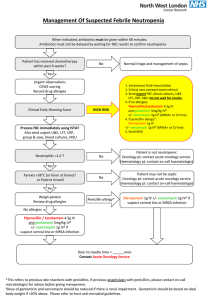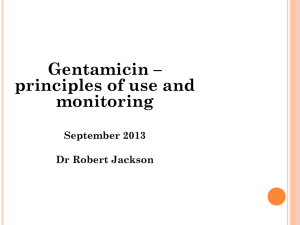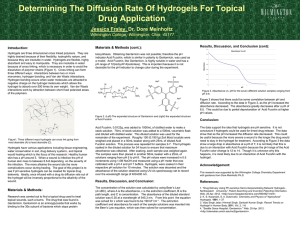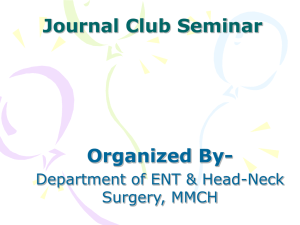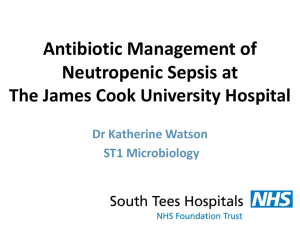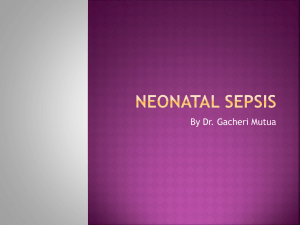Outcomes of IT Gentamicin Injection
advertisement
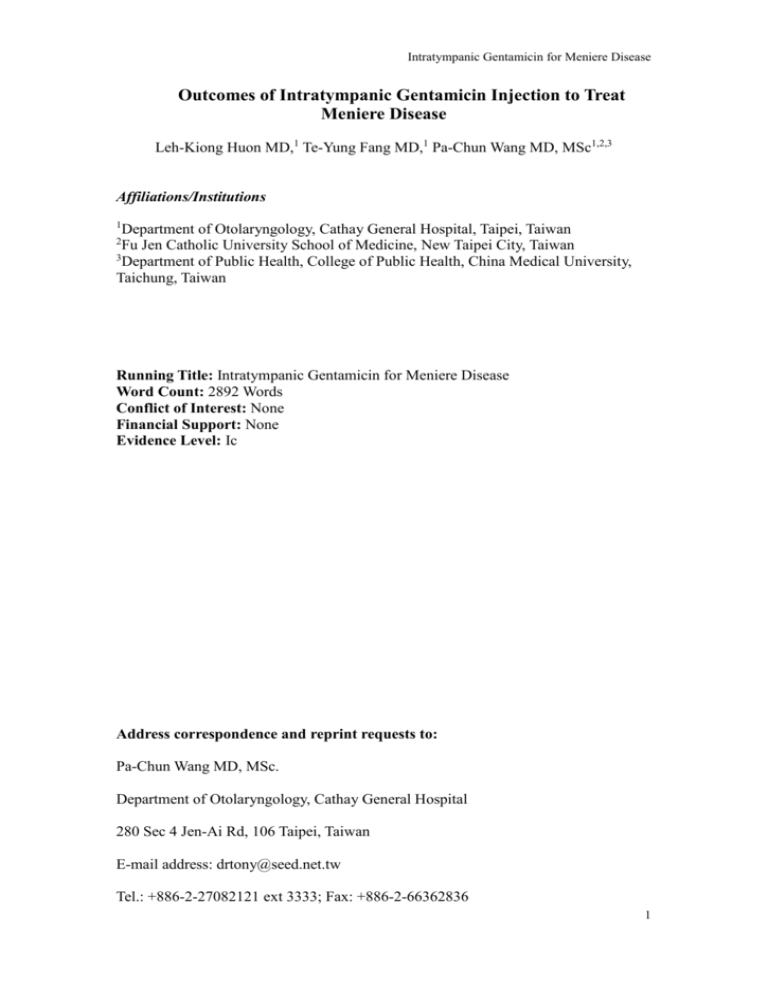
Intratympanic Gentamicin for Meniere Disease Outcomes of Intratympanic Gentamicin Injection to Treat Meniere Disease Leh-Kiong Huon MD,1 Te-Yung Fang MD,1 Pa-Chun Wang MD, MSc1,2,3 Affiliations/Institutions 1 Department of Otolaryngology, Cathay General Hospital, Taipei, Taiwan Fu Jen Catholic University School of Medicine, New Taipei City, Taiwan 3 Department of Public Health, College of Public Health, China Medical University, Taichung, Taiwan 2 Running Title: Intratympanic Gentamicin for Meniere Disease Word Count: 2892 Words Conflict of Interest: None Financial Support: None Evidence Level: Ic Address correspondence and reprint requests to: Pa-Chun Wang MD, MSc. Department of Otolaryngology, Cathay General Hospital 280 Sec 4 Jen-Ai Rd, 106 Taipei, Taiwan E-mail address: drtony@seed.net.tw Tel.: +886-2-27082121 ext 3333; Fax: +886-2-66362836 1 Intratympanic Gentamicin for Meniere Disease ABSTRACT Objective: To investigate the outcomes of intratympanic (IT) gentamicin sulfate injection to treat intractable Meniere disease (MD) using evidence-based methods. Data Source: Data were retrieved from a MEDLINE search (January 1995 through January 2011). Study Selection: Selected were English-language articles presenting outcomes of IT gentamicin injection to treat MD that had a prospective study design and an evidence level of II or higher. Data Extraction: The database was searched using Boolean combinations of the keywords intratympanic, gentamicin, and Meniere disease. Data Synthesis: Dichotomous outcomes (success rate and total deafness) were expressed using a Mantel-Haenszel fixed-effects model. Pretreatment and posttreatment pure-tone audiometry results and word discrimination scores were summarized using data synthesis techniques. Conclusions: A critical literature appraisal and meta-analysis shows that IT gentamicin injection can control vertigo in patients with MD who have limited hearing injury. The quality of research in this field has improved remarkably over the years. However, a large-scale randomized controlled trial is warranted to confirm the predictive factors for the effectiveness of IT gentamicin injection in treating MD. Key Words: adult, antibiotics, ear, evidence-based medicine, hearing loss, vertigo 2 Intratympanic Gentamicin for Meniere Disease INTRODUCTION Meniere disease (MD) is an idiopathic inner ear condition characterized by tinnitus, fluctuating hearing impairment, and episodic spinning vertigo. Various treatment options exist, including a salt restriction diet, medication, and shunt or labyrinthine ablation surgical procedures. Intratympanic (IT) gentamicin sulfate injection for the treatment of MD has recently gained increasing popularity, partially because of its convenience, safety, and efficacy. Injections can be administered in an ambulatory setting, with selective labyrinthine ototoxic effects. Several systematic reviews1-4 have proved the clinical efficacy of IT gentamicin injection to treat MD. Several modalities of IT gentamicin injection have been proposed to treat MD, including fixed, titration, or continuous protocols based on single, daily, or weekly schedules. However, because of difficulties in conducting randomized controlled trials, evidence-based consensus on the most appropriate IT gentamicin injection protocol for the treatment of MD has not been established. Furthermore, previous systematic reviews1-4 failed to identify patient characteristics or therapeutic variables that may confound the outcomes of IT gentamicin injection. Meta-analysis represents a powerful tool to pool data across studies and to increase the chance of detecting statistically significant treatment effects. The objectives of this study were as follows: (1) to identify and review evidence-based studies on IT gentamicin injection to treat intractable MD, (2) to pool the data and perform meta-analysis to increase the statistical power of treatment efficacy, and (3) to explore patient characteristics (sex, age, disease severity, and disease duration) and therapeutic variables (total number of injections and cumulative dose) that may affect the outcomes of IT gentamicin injection to treat MD. 3 Intratympanic Gentamicin for Meniere Disease MATERIALS AND METHODS Literature Search The MEDLINE database (January 1995 through January 2011) was searched using the following Boolean combinations of keywords: intratympanic and Meniere disease, gentamicin and Meniere disease, and intratympanic and gentamicin and Meniere disease. The search was supplemented by identifying additional listings using the feature to link with related articles from each of the original articles. Duplicate results were excluded. The quality of articles was assessed through independent cross-checking by 2 of us (L.K.H. and P.C.W.). Article Selection Criteria and Data Extraction Our systematic review of current literature was based on articles published in peer-reviewed journals up to and including January 2011. Only original articles were considered. To identify published studies for inclusion in this analysis, study populations had to include patients undergoing IT gentamicin injection for MD; publications had to address outcomes of IT gentamicin injection to treat MD. We excluded letters to editors, case series (<10 cases), review articles, and publications available only in abstract format. Studies had to have been conducted on humans. Non–English-language publications were excluded. Observations and Outcomes The selected articles were screened for the following: study design (prospective or retrospective clinical trial, controlled, or randomized), population size, patient demographics (sex and age), clinical characteristics (disease classification, hearing 4 Intratympanic Gentamicin for Meniere Disease impairment, tinnitus, aural fullness, vestibular dysfunction, disease duration, disease severity or stage, functional level, or subjective symptom survey results), treatment protocol (fixed or titration, total number of injections, and cumulative dose), and follow-up period. Using the American Academy of Otolaryngology–Head and Neck Surgery, Inc5 guidelines for the diagnosis and evaluation of therapy in MD (AAO-HNS guidelines), the following were described: vertigo control (class A-F), pure-tone audiometry (PTA) results (mean at 250, 1000, 2000, and 3000 Hz), word discrimination scores (WDS) percentage change, functional level (range, 1-6), vestibular dysfunction (percentage deficit on the caloric test), and subjective symptom survey results (tinnitus, aural fullness, and Tumarkin crisis [drop attack]). We defined substantial vertigo control as class A or B using the AAO-HNS guidelines.5 Hearing changes of 10 dB in PTA results and 15% in WDS were considered clinically significant. Change in tinnitus and aural fullness (better, same, or worse) was recorded. Study Hypotheses There were 4 study hypotheses: (1) Intratympanic gentamicin injection can control vertigo in patients with MD. (2) Intratympanic gentamicin injection can cause further hearing damage in patients with MD. (3) Intratympanic gentamicin injection treatment protocol and cumulative dose can affect vertigo control and hearing outcomes. (4) Confounders of IT gentamicin injection include clinical characteristics, such as disease classification, disease duration, disease severity or stage, and functional level. 5 Intratympanic Gentamicin for Meniere Disease Data Analysis Data were extracted and systemically reviewed. Dichotomous (substantial control of ITG, total deafness) outcomes were expressed using Mantel-Haenszel fixed-effects model, and the odds ratio was calculated. If the 95% CI did not include 1.00, it was considered significant at p < 0.05. The results for the overall outcomes (pretreatment and posttreatment means [SDs] and the effect mean [SD]) of IT gentamicin injection were summarized. Data synthesis techniques were used for PTA results and WDS. Cochran Q test for determining heterogeneity was also applied. Sample population differences between studies were considered significant at p < 0.05. RESULTS Study Characteristics The MEDLINE search revealed 14 original articles6-19 dealing with the use of IT gentamicin injection for the treatment of MD. The article selection algorithm is shown in Figure 1. Two studies15,18 used control groups, and their results were graded as level I evidence; in terms of research quality, the remaining 12 articles6-14,16,17,19 would be graded as containing level II evidence. The participants in the 14 studies (sample size range, 11-127) totaled 599 patients with MD who received IT gentamicin injection. Study characteristics are given in Table 1. In terms of clinical characteristics, the populations were heterogeneous across studies (p < 0.05). Treatment Protocol Among the reviewed articles, IT gentamicin injection was administered using 6 Intratympanic Gentamicin for Meniere Disease fixed protocols in 7 studies.7-10,15-17 Intratympanic gentamicin injection was administered using titration protocols in 7 studies.6,11-14,18,19 The studies were further classified according to their protocol for meta-analysis.2 The results showed that no study had a multiple daily protocol, 1 study had a weekly protocol, 6 studies had low-dose and high-dose (1-2 injections and fixed) protocols, no study had a continuous protocol with microcatheter, no study had a titration daily protocol, and 7 studies had titration weekly protocols. Among studies, the mean number of IT gentamicin injections was 2.1 (1.1), with a mean cumulative dose of 27.7 (20.5) mg (fixed range, 7.4-90.8 mg; titration range, 8.8-32.4 mg). Eight studies had more than 2.1 injections; 11 studies had a cumulative dose exceeding 13.4 mg. The treatment protocols are summarized in Table 1. Patient Assessments and Outcomes Measures Based on objective assessments by patients, PTA was performed in 11 studies,7-11,13,14,16-19 WDS in 6 studies,7,10,14,16,17,19 and caloric test in 12 studies.6-14,16,17,19 Among other physiological or imaging tests, electrocochleography was included in 1 study,8 rotating chair in 2 studies,13,14 auditory brainstem-evoked potentials in no study, vestibular evoked myogenic potentials in 1 study,9 computed tomography in 2 studies,10,11 and magnetic resonance imaging in 3 studies.7,10,11 All studies used outcomes measures consistent with AAO-HNS guidelines.5 Seven articles6,7,10,13,14,16,17 used subjective symptoms as outcomes end points, including the Functional Level Scale5 in 7 studies, the University of California, Los Angeles Dizziness Questionnaire20 in 2 studies, the Dizziness Handicap Inventory21 in 2 studies, and the Vertigo Symptom Scale22 in 1 study. No article used the general health survey. 7 Intratympanic Gentamicin for Meniere Disease Patient Characteristics The study populations ranged in age from 46.1 to 59 years, with a mean age of 53.4 years. The proportion of male patients in 8 studies6,7,9,11-14,17 that provided this information ranged from 32.1% to 60%. Eight studies6,7,9,11-14,17 reported the disease duration; 11 studies6,7,9-14,16,17,19 reported the type and stage (severity) of MD. The mean disease duration was 78.9 (2.1) months (range, 27.6-117.6 months); 1 patient had had MD for more than 10 years. The mean follow-up time was 49.8 (10.0) months (range, 12.0-63.6 months); 10 studies6,8,10-14,16,17,19 followed up patients for more than 24 months. At baseline, patients in all studies had definitive MD; 8 studies6,9,10,12-14,17,19 provided staging data for 388 patients. Among these, the stages of disease were stage I in 17 patients (4.4%), stage II in 43 patients (11.1%), stage III in 236 patients (60.8%), and stage IV in 92 patients (23.7%). Outcomes of IT Gentamicin Injection The degree of vertigo control among 559 patients with MD was as follows: class A in 457 patients (71.4%), class B in 59 patients (16.1%), class C in 15 patients (4.3%), class D in 7 patients (2.4%), class E in 10 patients (2.9%), and class F in 11 patients (2.9%). The overall success rate of IT gentamicin injection in treating MD was 87.5% (95% CI, 81.1%-92.0%; p < 0.001). Based on preestablished criteria for substantial vertigo control, meta-analysis demonstrated that IT gentamicin injection effectively treated MD. The treatment effect is summarized in Figure 2. Among 14 articles, mean (SD) pretreatment and posttreatment data were provided on PTA results in 11 studies,7-11,13,14,16-19 on WDS in 6 studies,7,10,14,16,17,19 8 Intratympanic Gentamicin for Meniere Disease and on caloric test results in no study. The weighted mean PTA results changed from 58.5 (14.2) dB to 54.9 (18.5) dB following IT gentamicin injection (overall P = .09). The weighted mean WDS changed from 50.4% (30.4%) to 52.2% (32.4%) following IT gentamicin injection (overall p = 0.07). The mean hearing variable changes of 2.8 (1.7) dB (range, 0.9-6.0 dB) and 2.9% (1.6%) (range, 3.5%-11.4%) were not clinically significant. Eleven of 599 patients (1.8%) experienced total deafness.11,14 The improvement in tinnitus (among 77 out of 621 patients [12.4%]) was significant (P = .02). The improvement in aural fullness (among 48 out of 623 patients [7.7%]) was not significant (p = 0.06). Quality-of-life questionnaires were used in 7 studies.6,7,10,13,14,16,17 The efficacy of IT gentamicin injection for the treatment of MD as assessed by subjective symptom survey results shows remarkable improvement (Figure 3). Detailed results of the use of IT gentamicin injection in treating MD are given in Table 2. Effect of Treatment Protocol The pooled success rates of fixed protocols (87.5% [range, 56.3%-97.5%]) vs titration protocols (88.2% [range, 71.0%-97.1%]) were not significantly different (p = 0.94). Patients treated with titration protocols of IT gentamicin injection did not have higher rates of vertigo control (Figure 4). The weighted mean PTA changes of fixed protocols (2.2 [2.0] dB [range, 0.9-8.5 dB]) vs titration protocols (4.1 [2.9] dB [range, 1.0-6.0 dB]) were not significantly different (p = 0.09). Patients treated with titration protocols of IT gentamicin injection did not have greater deterioration in PTA results (Figure 5). The weighted mean WDS changes of fixed protocols (0% [range, 3.5%-11.4%]) vs titration protocols (4% [range, 4%]) were not significantly different (p = 0.07). 9 Intratympanic Gentamicin for Meniere Disease Patients treated with titration protocols of IT gentamicin injection did not have greater reduction in WDS (Figure 6). The pooled tinnitus improvement rates of fixed protocols (15.5% [range, 13.3%-18.2%]) vs titration protocols (43.5% [range, 0.4%-47.9%]) were significantly different (p = 0.02). Patients treated with titration protocols of IT gentamicin injection had higher tinnitus improvement rates (Figure 7a). The pooled aural fullness improvement rates of fixed protocols (38.5% [range, 36.4%-40.0%]) vs titration protocols (39.1% [range, 0.4%-45.6%]) were not significantly different (p = 0.06). Patients treated with titration protocols of IT gentamicin injection did not have higher aural fullness improvement rates (Figure 7a). The pooled rates of worse hearing for fixed protocols (17% [range, 6.7%-27.3%]) vs titration protocols (17.2% [range, 0.4%-38.7%]) were not significantly different (p = 0.81). Patients treated with titration protocols of IT gentamicin injection did not have higher rates of worse hearing (Figure 7b). Outcomes Confounders In 6 titration protocol studies,6,11,13,14,18,19 patients with IT gentamicin sulfate injection cumulative dose exceeding 13.4 mg had better rates of vertigo control (odds ratio, 6.0; 95% CI, 1.7-21.1) (p = 0.005). These results are summarized in Figure 8. DISCUSSION Labyrinthine chemical ablation to treat MD was first introduced by Schuknecht23 in 1957. To reduce the risk of hearing damage, streptomycin sulfate was later replaced by other aminoglycosides (such as gentamicin sulfate) with selective vestibular toxic effects. Over the past decade, IT gentamicin injection has gained popularity because 10 Intratympanic Gentamicin for Meniere Disease of its advantages over surgical ablation in convenience, efficacy, and safety. However, many of the outcomes data are from small intervention studies7-9,14-19 with fewer than 50 participants, and it is difficult to conduct randomized controlled trials among patients with intractable MD.15,16 Because the validity of data from a single study is often questioned, there has been no consensus on the most appropriate treatment protocol. Potential hearing damage is another concern. Several systematic reviews1-4 have attempted to explore the efficacy and complications of IT gentamicin injection, with varying conclusions. To increase statistical power across studies, we used meta-analysis herein to pool published data. Eleven studies6,7,9-14,16,17,19 of 14 targeted definitive MD, and all studies6-19 used AAO-HNS guidelines5 for the diagnosis and evaluation of therapy in MD. Although there was heterogeneity in the distribution of disease severity, the format of standardized input of clinical information enabled data synthesis. All reviewed studies herein reported categorized treatment protocols (fixed protocols in 7 studies7-10,15-17 and titration protocols in 7 studies6,11-14,18,19), which enabled hypothesis testing on various dosing schedules. We used stricter criteria for article selection than Chia et al2 or Diamond et al1 to restrict studies with prospective design; however, only 2 selected studies15,18 used randomized controlled trials. For overall vertigo control, our meta-analysis results are compatible with those of previous reviews1-4 showing that IT gentamicin injection is effective in treating MD (Figure 2). The pooled 71.4% rate of complete vertigo control and 87.5% rate of substantial vertigo control (class A and B) are similar to those reported by Cohen-Kerem et al3 (74.7% rate of complete vertigo control and 92.7% rate of substantial vertigo control). The control rates of different treatment protocols were similar to those reported by Cohen-Kerem et al3 and by Diamond et al,1 with our 11 Intratympanic Gentamicin for Meniere Disease review finding no difference in the rates of vertigo control between fixed and titration protocol groups (Figure 4). This differs from results of the study by Chia et al,2 in which the titration method demonstrated a significantly better 81.7% rate of complete vertigo control than the 66.7% rate of the low-dose fixed method. Among a handful of reviewed articles,6,12,14,16,17 the pooled data showed significant (p = 0.02) but variable tinnitus improvement rates (range, 0.4%-47.9%) (Figure 7a). A large variation in tinnitus improvement rates (mean, 57% [range, 0%-82%]) was also found by Diamond et al.1 Boleas-Aguirre et al6 reported that 15.5% of patients still experience unsteadiness after IT gentamicin injection to treat MD. Quality-of-life outcomes are considered important in the treatment of MD. However, only 5 reviewed studies6,13,20-22 used subjective symptom surveys. Seven studies6,7,10,13,14,16,17 reported functional levels as recommended by the AAO-HNS guidelines5 (Figure 3), but no study reported the general health status of patients following interventions. Unfortunately, the effect of IT gentamicin injection on functional levels of patients cannot be assessed because of the lack of pretreatment and posttreatment data from individual participants. The importance of the functional implications of IT gentamicin injection for the treatment of MD cannot be overemphasized and may warrant future studies. Critical appraisal of the selected articles in this study shows that catastrophic consequences of IT gentamicin injection, such as total deafness or Tumarkin crisis, are rare, with no occurrences in this pooled intervention population of 599 patients. This finding proves that IT gentamicin injection is a safe treatment for MD. A review4 of 2 randomized controlled trials15,18 on the cochleotoxic effects of IT gentamicin injection reports up to 25% hearing loss. However, our study indicates 12 Intratympanic Gentamicin for Meniere Disease that cochlear damage associated with IT gentamicin injection, in terms of PTA results and WDS, is clinically negligible (Figures 5, 6, and 7b). This is compatible with findings by Cohen-Kerem at al.3 As to different IT gentamicin injection delivery protocols, Chia et al2 found that the weekly titration method yielded less overall hearing loss than the multiple daily method. However, our study showed no difference in hearing loss rates between the fixed and titration protocol groups. Several reviews state that the appropriate cumulative dose of gentamicin for the best clinical results with the least amount of hearing loss has not been determined. Diamond et al1 provided rates of vertigo control by gentamicin sulfate concentration (91% control with 40 mg/mL, 91% with 30 mg/mL, and 89% with <30 mg/mL), but no cumulative dose information, data synthesis, or meta-analysis was provided in their study. Herein, the differences in regimens and the variability among patient groups made it difficult to investigate any dose-response relationship or to identify an optimal threshold dose. Nevertheless, we estimated cumulative doses of gentamicin based on the concentration and injection profiles among individual patients. A cumulative dose exceeding 13.4 mg of gentamicin sulfate is the threshold that may result in treatment success. This dose can be easily achieved during the first few injections using fixed or titration protocols. The heterogeneity of baseline disease severity and the lack of severity-related outcomes data prevented us from further exploring the role of MD severity in IT gentamicin injection treatment. We also failed to identify any confounding effects of other characteristics of patients. Our systematic review had additional limitations, as clinical information like middle ear condition or genetic susceptibility, for example, cannot be assessed from a literature review. These information gaps may warrant future research. 13 Intratympanic Gentamicin for Meniere Disease In conclusion, based on the best evidence in the existing literature, this systematic review finds that IT gentamicin injection is effective in treating vertigo, tinnitus, and aural fullness caused by MD, whether delivered by fixed or titration protocols. Hearing damage associated with this intervention is minimal. A cumulative dose of gentamicin sulfate exceeding 13.4 mg is predictive of successful treatment. The quality of research in this field has improved remarkably over the years. However, a large-scale randomized controlled trial is warranted to confirm the predictive factors for the effectiveness of IT gentamicin injection in treating MD. ACKNOWLEDGMENTS We thank Li-Ju Chuang at the Cathay Medical Research Institute, Cathay General Hospital, Taipei, Taiwan, for data management in this project. This study was presented at the 2011 Annual Meeting & OTO EXPO of the American Academy of Otolaryngology–Head and Neck Surgery Foundation; September 13, 2011; San Francisco, California. 14 Intratympanic Gentamicin for Meniere Disease REFERENCES 1. Diamond C, O’Connell DA, Hornig JD, et al. Systematic review of intratympanic gentamicin in Meniere’s disease. J Otolaryngol 2003;32:351–61. 2. Chia SH, Gamst AC, Anderson JP, Harris JP. Intratympanic gentamicin therapy for Ménière’s disease: A meta-analysis. Otol Neurotol 2004;25:544–52. 3. Cohen-Kerem R, Kisilevsky V, Einarson TR, et al. Intratympanic gentamicin for Menière’s disease: A meta-analysis. Laryngoscope 2004;114:2085–91. 4. Pullens B, van Benthem PP. Intratympanic gentamicin for Ménière’s disease or syndrome. Cochrane Database Syst Rev 2011;16:CD008234. 5. American Academy of Otolaryngology–Head and Neck Foundation, Inc. Committee on Hearing and Equilibrium guidelines for the diagnosis and evaluation of therapy in Menière’s disease. Otolaryngol Head Neck Surg 1995;113:181–5. 6. Boleas-Aguirre MS, Sánchez-Ferrandiz N, Guillén-Grima F, et al. Long-term disability of class A patients with Ménière’s disease after treatment with intratympanic gentamicin. Laryngoscope 2007;117:1474–81. 7. Casani A, Nuti D, Franceschini SS, et al. Transtympanic gentamicin and fibrin tissue adhesive for treatment of unilateral Menière’s disease: Effects on vestibular function. Otolaryngol Head Neck Surg 2005;133:929–35. 8. Horii A, Saika T, Uno A, et al. Factors relating to the vertigo control and hearing changes following intratympanic gentamicin for intractable Ménière’s disease. Otol Neurotol 2006;27:896–900. 9. Helling K, Schönfeld U, Clarke AH. Treatment of Ménière’s disease by low-dosage intratympanic gentamicin application: Effect on otolith function. Laryngoscope 2007;117:2244–50. 15 Intratympanic Gentamicin for Meniere Disease 10. Harner SG, Driscoll CL, Facer GW, et al. Long-term follow-up of transtympanic gentamicin for Ménière’s syndrome. Otol Neurotol 2001;22:210–4. 11. Kaasinen S, Pyykkö I, Ishizaki H, Aalto H. Intratympanic gentamicin in Meniere’s disease. Acta Otolaryngol 1998;118:294–8. 12. Lange G, Maurer J, Mann W. Long-term results after interval therapy with intratympanic gentamicin for Menière’s disease. Laryngoscope 2004;114:102–5. 13. Martin E, Perez N. Hearing loss after intratympanic gentamicin therapy for unilateral Ménière’s disease. Otol Neurotol 2003;24:800–6. 14. Minor LB. Intratympanic gentamicin for control of vertigo in Meniere’s disease: Vestibular signs that specify completion of therapy. Am J Otol 1999;20:209–19. 15. Postema RJ, Kingma CM, Wit HP, et al. Intratympanic gentamicin therapy for control of vertigo in unilateral Menière’s disease: A prospective, double-blind, randomized, placebo-controlled trial. Acta Otolaryngol 2008;128:876–80. 16. Quaranta A, Aloisi A, De Benedittis G, et al. Intratympanic therapy for Ménière’s disease: High-concentration gentamicin with round-window protection. Ann N Y Acad Sci 1999;884:410–24. 17. Quaranta A, Scaringi A, Aloidi A, et al. Intratympanic therapy for Ménière’s disease: Effect of administration of low concentration of gentamicin. Acta Otolaryngol 2001;121:387–92. 18. Stokroos R, Kingma H. Selective vestibular ablation by intratympanic gentamicin in patients with unilateral active Ménière’s disease: A prospective, double-blind, placebo-controlled, randomized clinical trial. Acta Otolaryngol 2004;124:172–5. 19. Wu IC, Minor LB. Long-term hearing outcome in patients receiving intratympanic gentamicin for Ménière’s disease. Laryngoscope 2003;113:815–20. 16 Intratympanic Gentamicin for Meniere Disease 20. Honrubia V, Bell TS, Harris MR, Baloh RW, Fisher LM. Quantitative evaluation of dizziness characteristics and impact on quality of life. Am J Otol 1996;17:595–602. 21. Jacobson GP, Newman CW. The development of the Dizziness Handicap Inventory. Arch Otolaryngol Head Neck Surg 1990;116:424–7. 22. Yardley L, Hallam RS. Psychosocial aspects of balance and gait disorders. In: Bronstein AM, Brandt T, Wollacott M, eds. Clinical Disorders of Balance, Posture and Gait. London: Arnold, 1996;194–210. 23. Schuknecht HF. Ablation therapy in the management of Menière’s disease. Acta Otolaryngol Suppl 1957;132:1–42. 17 Intratympanic Gentamicin for Meniere Disease FIGURE LEGENDS Figure 1. Article selection algorithm showing that the MEDLINE search revealed 14 original articles dealing with intratympanic gentamicin sulfate injection for Meniere disease between January 1995 and January 2011. Figure 2. Treatment effect of intratympanic gentamicin sulfate injection for Meniere disease. The success rate for substantial vertigo control is 56.3% to 97.5% (95% CI, 81.1%-92.0%) (overall p < 0.001). Figure 3. Results on the Functional Level Scale before and after treatment in 7 studies (388 participants). Figure 4. Treatment effect of different intratympanic gentamicin sulfate injection protocols. The success rates for substantial vertigo control are not significantly different for fixed vs titration protocols (odds ratio, 1.07; 95% CI, 0.17-6.58) (overall p = 0.94). Figure 5. Treatment effect of different intratympanic gentamicin sulfate injection protocols. The weighted mean (SD) pure-tone audiometry results change from 58.5 (14.2) dB to 54.9 (18.5) dB (p = 0.09). Figure 6. Treatment effect of different intratympanic gentamicin sulfate injection protocols. The weighted mean (SD) word discrimination scores change from 50.4% (30.4%) to 52.2% (32.4%) (p = 0.07). 18 Intratympanic Gentamicin for Meniere Disease Figure (7a). Treatment effect of different intratympanic gentamicin sulfate injection protocols. The tinnitus improvement rate is 0.4% to 47.9% (95% CI, 0.2%-0.5%) (overall p = 0.02). The aural fullness improvement rate is 0.4% to 45.6% (95% CI, 0.2%-1.0%) (overall p = 0.06). (7b). Treatment effect of different intratympanic gentamicin sulfate injection protocols. The rate of worse hearing is 0.4% to 38.7% (95% CI, 0.1%-1.0%) (overall p = 0.81). Figure 8. In the titration protocol studies, patients with a cumulative dose of gentamicin sulfate exceeding 13.4 mg had better rates of vertigo control (odds ratio, 6.0; 95% CI, 1.7-21.1) (p = 0.005). 19 Intratympanic Gentamicin for Meniere Disease Table 1. Summary of Treatment Protocols Study Design Patients (n) Age Concentration (mg/mL) Treatment Protocol Treatment Content Total Injections Casani, et al. (2005)7 prospective 26 58 20 fixed low dose 1.2±0.6 prospective 28 51.4 26 fixed low dose 3 prospective 19 53.7 12 fixed low dose 1.4±0.6 prospective 56 57 40 fixed low dose 1.6±0.9 prospective, double blinded, randomized 16 53 30 fixed weekly prospective 11 52.9 80 fixed high dose 2.3±0.4 prospective 15 46.1 20 fixed low dose 2.7±6.8 prospective 127 53 26.7 titration titration weekly 3±2 prospective 93 50.9 30 titration titration weekly 2.4±1.0 prospective 57 54 12 titration titration weekly 1.5±0.8 prospective 71 53.6 26.7 titration titration weekly 2.5 prospective 34 53 26.7 titration titration weekly 2.8±1.3 prospective, double blinded, randomized 12 59 30 titration titration weekly 1.5±0.5 prospective 34 52.3 26.7 titration titration weekly 2.7±1.5 Horii, et al. (2006)8 Helling, et al. (2009)9 Harner, et al. (2001)10 Postema, et al. (2008)15 4 Quaranta, et al. (1999)16 Quaranta, et al. (2001)17 Boleas-Aguirre, et al. (2007)6 Kaasinen, et al. (1998)11 Lange, et al. (2004)12 Martin and Perez (2003)13 Minor (1999)14 Stokroos and Kingma (2004)18 Wu and Minor (2003)19 20 Intratympanic Gentamicin for Meniere Disease Table 2. Summary of Outcomes of Intratympanic Gentamicin Sulfate Injection to Treat Meniere Disease Study Patients (n) Treatment Protocol Substantial Vertigo Control (A+B) Hearing Worse Tinnitus Better Aural Fullness Better 26 fixed low dose 23 (88.5%) 5 (19.2%) - - 28 fixed low dose 27 (96.4%) 3 (10.7%) - - 19 fixed low dose 19 (100.0%) - - - 56 fixed low dose 46 (82.1%) 10 (17.9%) - - 16 fixed weekly 9 (56.3%) - - - 11 fixed high dose 11 (100.0%) 3 (27.3%) 2 (18.2%) 4 (36.4%) 15 fixed low dose 14 (93.3%) 1 (6.7%) 2 (13.3%) 6 (4.0%) 127 titration weekly 112 (88.2%) 0 0 0 93 titration weekly 66 (71.0%) 36 (38.7%) - - 57 titration weekly 54 (94.7%) 5 (8.8%) 26 (45.6%) 26 (45.6%) 71 titration weekly 59 (83.1%) 11 (15.5%) 34 (47.9%) 34 titration weekly 31 (91.2%) 11 (32.4%) 13 (38.2%) 12 (35.3%) 12 titration weekly 12 (100.0%) - - - 34 titration weekly 33 (97.1%) 6 (17.6%) - - Casani, et al. (2005)7 Horii, et al. (2006)8 Helling, et al. (2009)9 Harner, et al. (2001)10 Postema, et al. (2008)15 Quaranta, et al. (1999)16 Quaranta, et al. (2001)17 Boleas-Aguirre, et al. (2007)6 Kaasinen, et al. (1998)11 Lange, et al. (2004)12 Martin and Perez (2003)13 Minor (1999)14 Stokroos and Kingma (2004)18 Wu and Minor (2003)19 21 Intratympanic Gentamicin for Meniere Disease Figure 1. Article selection algorithm showing that the MEDLINE search revealed 14 original articles dealing with intratympanic gentamicin sulfate injection for Meniere disease between January 1995 and January 2011. 196 titles identified from literature search (“ITG”∩”MD”) 128 excluded at brief-screener level after removal of duplicates or clearly irrelevant 68 articles identified at brief-screener level then sent for extended-screener review 68 identified at extended-screener level Retrospective Prospective Randomized + placebo-controlled + double blind 52 14 2 54 excluded at extended-screener level Retrospective 52 Prospective 2 1 study population <10 1 study data unclear 14 included in primary analysis Prospective Randomized + placebo-controlled + double blind 12 2 22 Intratympanic Gentamicin for Meniere Disease Figure 2. Treatment effect of intratympanic gentamicin sulfate injection for Meniere disease. The success rate for substantial vertigo control is 56.3% to 97.5% (95% CI, 81.1%-92.0%) (overall p < 0.001). Study Casani, et al. (2005)7 Horii, et al. (2006)8 Helling, et al. (2009)9 Harner, et al. (2001)10 Postema, et al. (2008)15 Quaranta, et al. (1999)16 Quaranta, et al. (2001)17 Boleas-Aguirre, et al. (2007)6 Kaasinen, et al. (1998)11 Lange, et al. (2004)12 Martin, et al. (2003)13 Minor, et al. (1999)14 Stokroos, et al (2004)18 Wu, et al. (1999)19 Overall (p= 0.000) Success Rate (95% CI) 0.9(0.7-1) 1(0.8-1) 1(0.7-1) 0.81(0.7-0.9) 0.6 (0.3-0.8) 1(0.6-1) 0.91(0.6-1) 0.9(0.8-0.9) 0.7(0.6-0.8) 1(0.8-1) 0.8 (0.7-0.9) 0.9 (0.8-1) 1(0.6-1) 1(0.8-1) 0.9(0.8-1) Success Rate and 95% CI -1 -0.5 0 0.5 23 1 Intratympanic Gentamicin for Meniere Disease Figure 3. Results on the Functional Level Scale before and after treatment in 7 studies (388 participants). 24 Intratympanic Gentamicin for Meniere Disease Figure 4. Treatment effect of different intratympanic gentamicin sulfate injection protocols. The success rates for substantial vertigo control are not significantly different for fixed vs titration protocols (odds ratio, 1.07; 95% CI, 0.17-6.58) (overall p = 0.94). Study Fixed Protocol Casani, et al. (2005)7 Horii, et al. (2006)8 Helling, et al. (2009)9 Harner, et al. (2001)10 Postema, et al. (2008)15 Quaranta, et al. (1999)16 Quaranta, et al. (2001)17 Titration Protocol Boleas-Aguirre, et al. (2007)6 Kaasinen, et al. (1998)11 Lange, et al. (2004)12 Martin and Perez (2003)13 Minor (1999)14 Stokroos and Kingma (2004)18 Wu and Minor (2003)19 Overall (p= 0.94) Odds Ratio (95% CI) Odds Ratio and 95% CI 0.1 (0.0-1.5) 0.0 (0.0-0.7) 0.0 (0.0-0.6) 0.1 (0.0-2.0) 0.3 (0.0-7.4) 0.0 (0.0-1.0) 0.0 (0.0-1.3) 21.8 (0.8-558.4) 7.3 (0.3-183.6) 46.7 (1.6-1369.5) 14.3 (0.5-371.3) 27.0 (0.9-797.6) 75.0 (1.0-5364.9) 67.0 (1.8-2438.3) 1.1 (0.2-6.6) 0.01 0.1 1 10 25 100 Intratympanic Gentamicin for Meniere Disease Figure 5. Treatment effect of different intratympanic gentamicin sulfate injection protocols. The weighted mean (SD) pure-tone audiometry results change from 58.5 (14.2) dB to 54.9 (18.5) dB (p = 0.09). Study Fixed Protocol Casani et al. (2005)7 Horii et al. (2006)8 Quaranta et al. (1999)16 Quaranta et al. (2001)17 Titration Protocol Minor (1999)14 Stokroos and Kingma (2004)18 Wu and Minor (2003)19 Overall (p= 0.09) Mean Difference (95% CI) Mean Difference and 95% CI −2.4 (−9.1 to 4.3) 8.5 (0.8 to 16.2) 0.9 (−7.6 to 9.4) 3.7 (−6.2 to 13.6) 1.0 (−8.2 to 10.2) 6.0 (−2.3 to 14.3) 6.0 (−9.7 to 21.7) 2.8 (−0.5 to 6.1) -50 -25 0 25 26 50 Intratympanic Gentamicin for Meniere Disease Figure 6. Treatment effect of different intratympanic gentamicin sulfate injection protocols. The weighted mean (SD) word discrimination scores change from 50.4% (30.4%) to 52.2% (32.4%) (p = 0.07). Study Fixed Protocol Casani et al. (2005)7 Quaranta et al. (1999)16 Quaranta et al. (2001)17 Titration Protocol Minor (1999)14 Wu and Minor (2003)19 Overall (p= 0.07) Mean Difference (95% CI) Mean Difference and 95% CI −3.5 (−11.9 to 4.9) −9.1 (−23.9 to 5.7) 11.4 (0.3 to 22.5) 4.0 (−2.7 to 10.7) 4.0 (−0.3 to 8.3) 2.9 (−0.2 to 6.1) -50 -25 0 25 27 50 Intratympanic Gentamicin for Meniere Disease Figure (7a). Treatment effect of different intratympanic gentamicin sulfate injection protocols. The tinnitus improvement rate is 0.4% to 47.9% (95% CI, 0.2%-0.5%) (overall p = 0.02). The aural fullness improvement rate is 0.4% to 45.6% (95% CI, 0.2%-1.0%) (overall p = 0.06). Study Tinnitus Fixed Protocol Quaranta, et al. (1999)16 Quaranta, et al. (2001)17 Titration Protocol Boleas-Aguirre, et al. (2007)6 Lange, et al. (2004)12 Minor, et al. (1999)14 Overall (P=0.017) Fullness Fixed Protocol Quaranta, et al. (1999)16 Quaranta, et al. (2001)17 Titration Protocol Boleas-Aguirre, et al. (2007)6 Lange, et al. (2004)12 Minor, et al. (1999)14 Overall (p= 0.064) Better Rate (95% CI) Improvement Rate and 95% CI 0.2 (0-0.5) 0.1 (0-0.4) 0 (0-0.1) 0.5 (0.3-0.6) 0.5 (0.4-0.6) 0.3 (0.2-0.5) 0.4 (0.1-0.7) 0.4 (0.2-0.7) 0 (0-0.1) 0.5 (0.3-0.6) 0.4 (0.2-0.5) 0.3 (0.2-1) -1 -0.5 0 0.5 28 1 Intratympanic Gentamicin for Meniere Disease Figure 7b. Treatment effect of different intratympanic gentamicin sulfate injection protocols. The rate of worse hearing is 0.4% to 38.7% (95% CI, 0.1%-1.0%) (overall p = 0.81). Study Worse Rate (95% CI) Fixed Protocol Casani et al. (2005)7 Horii et al. (2006)8 Harner et al. (2001)10 Quaranta et al. (1999)16 Quaranta et al. (2001)17 0.2 (0.1-0.4) 0.1 (0.0-0.3) 0.2 (0.1-0.3) 0.3 (0.1-0.6) 0.1 (0.0-0.4) Titration Protocol Boleas-Aguirre et al. (2007)6 Kaasinen et al. (1998)11 Lange et al. (2004)12 Martin and Perez (2003)13 Minor (1999)14 Wu and Minor (2003)19 Overall (p= 0.81) 0.0 (0.0-0.1) 0.4 (0.3-0.5) 0.1 (0.0-0.2) 0.2 (0.1-0.3) 0.3 (0.2-0.5) 0.2 (0.1-0.3) 0.2 (0.1-1.0) Worse Rate and 95% CI -1 -0.5 0 0.5 29 1 Intratympanic Gentamicin for Meniere Disease Figure 8. In the titration protocol studies, patients with a cumulative dose of gentamicin sulfate exceeding 13.4 mg had better rates of vertigo control (odds ratio, 6.0; 95% CI, 1.7-21.1) (p = 0.005). Study Dose 13.4 mg Lange et al. (2004)12 Dose >13.4 mg Boleas-Aguirre et al. (2007)6 Kaasinen et al. (1998)11 Martin and Perez (2003)13 Minor (1999)14 Stokroos and Kingma (2004)18 Wu and Minor (2003)19 Overall (p= 0.005) Odds Ratio (95% CI) Odds Ratio and 95% CI 0.0 (0.0-0.6) 21.8 (0.8-558.4) 7.3 (0.3-183.6) 14.3 (0.5-371.3) 27.0 (0.9-797.6) 3.6 (0.1-97.2) 67.0 (1.8-2438.3) 6.0 (1.7-21.1) 0.01 0.1 1 10 100 30
